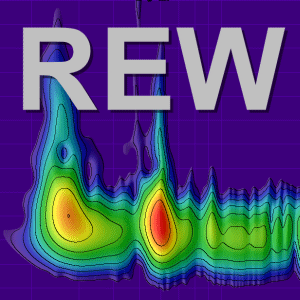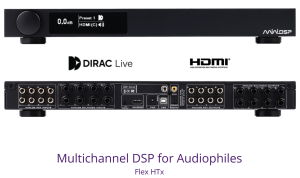Forgot to mention that the phase equalisation and matching will be constrained mostly below 1 kHz because it seems to have more perceptual ramifications there.The plan is to create a FIR inverse filter to compensate for both the magnitude and phase response followed by matching of the left and right channels such that both the magnitude and phase looks similar. The spatial measurements (per channel) are constrained to a smal listening zone to derive an average response representative of the zone to be optimised. Because the responses change significantly with a small change in the spatial locations, the equalisation of an average response is required to minimise overfitting and overcompensating by the inverse filter. Granted, the dispersion of the impulse response is an issue in these types of environments and it helps if option exist to minimise it. I think it will be a great idea to also have an averaging function based on an RMS averaged magnitude and a vector averaged phase to see which works better in this case. I will appreciate it if you can consider it.
-
AUDIO VIDEO PROCESSING, SETUP & ENVIRONMENTOfficial REW (Room EQ Wizard) Support Forum Audiolense User Forum Calibration Equipment Auto-EQ Platforms / Immersive Audio Codecs Video Display Technologies / Calibration AV System Setup and Support Listening Room / Home Theater Build Projects Room Acoustics and Treatments AV Showcase Movies / Music / TV / Streaming
-
AUDIO VIDEO DISCUSSION / EQUIPMENTHome Theater / Audio and Video - Misc Topics Essence For Hi Res Audio AV Equipment Advice and Pricing Awesome Deals and Budget AV Equipment AV Receivers / Processors / Amps UHD / Blu-ray / CD Players / Streaming Devices Two Channel Hi-Fi Equipment DIY Audio Projects Computer Systems - HTPC / Gaming HD and UHD Flat Screen Displays Projectors and Projection Screens AV Accessories Buy - Sell - Trade
Navigation
Install the app
How to install the app on iOS
Follow along with the video below to see how to install our site as a web app on your home screen.
Note: This feature may not be available in some browsers.
More options
You are using an out of date browser. It may not display this or other websites correctly.
You should upgrade or use an alternative browser.
You should upgrade or use an alternative browser.
V5.20.10 Early Access
- Thread starter John Mulcahy
- Start date
John Mulcahy
REW Author
Thread Starter
- Joined
- Apr 3, 2017
- Posts
- 8,461
That would be really, really problematic. None of those measurements, individually or collectively, are useful for inverse filtering, they are just too heavily contaminated by reflections, some much larger than the direct sound. I think your best options might be to take the rms average, generate a minimum phase response from it and EQ that or use the vector average to generate EQ for the region below a few hundred Hz.The plan is to create a FIR inverse filter to compensate for both the magnitude and phase response
Here is how the Hybrid average looks in any case, noise and acausal content in the impulse response are only 25 dB or so below the peak, which is a big issue for filter generation:
That would be really, really problematic. None of those measurements, individually or collectively, are useful for inverse filtering, they are just too heavily contaminated by reflections, some much larger than the direct sound. I think your best options might be to take the rms average, generate a minimum phase response from it and EQ that or use the vector average to generate EQ for the region below a few hundred Hz.
Here is how the Hybrid average looks in any case, noise and acausal content in the impulse response are only 25 dB or so below the peak, which is a big issue for filter generation:
View attachment 53558
View attachment 53556
Is the Hybrid average a combination of RMS average for magnitude and Vector average for phase? It sure looks that way to me from the screenshotsThat would be really, really problematic. None of those measurements, individually or collectively, are useful for inverse filtering, they are just too heavily contaminated by reflections, some much larger than the direct sound. I think your best options might be to take the rms average, generate a minimum phase response from it and EQ that or use the vector average to generate EQ for the region below a few hundred Hz.
Here is how the Hybrid average looks in any case, noise and acausal content in the impulse response are only 25 dB or so below the peak, which is a big issue for filter generation:
View attachment 53558
View attachment 53556
Quick question. How did you generate the magnitude and phase response in one screen like that?That would be really, really problematic. None of those measurements, individually or collectively, are useful for inverse filtering, they are just too heavily contaminated by reflections, some much larger than the direct sound. I think your best options might be to take the rms average, generate a minimum phase response from it and EQ that or use the vector average to generate EQ for the region below a few hundred Hz.
Here is how the Hybrid average looks in any case, noise and acausal content in the impulse response are only 25 dB or so below the peak, which is a big issue for filter generation:
View attachment 53558
View attachment 53556
I see the application of frequency smoothing in REW has no effect on the impulse response. Not that it will help much in this case but the application of smoothing could be one of the ways to minimise the noise in the impulse response. Is this a design decision not to do it this way?Here is how the Hybrid average looks in any case, noise and acausal content in the impulse response are only 25 dB or so below the peak, which is a big issue for filter generation:
John Mulcahy
REW Author
Thread Starter
- Joined
- Apr 3, 2017
- Posts
- 8,461
Yes. I have implemented it, I'm still mulling over whether it makes sense to release a build with it. Or whether to retain the Magn phase smoothing for that matter.Is the Hybrid average a combination of RMS average for magnitude and Vector average for phase?
That's just a capture of the SPL & Phase graph.Quick question. How did you generate the magnitude and phase response in one screen like that?
The time and frequency domains don't correspond in that way, there is no time domain equivalent to fractional octave smoothing. A constant bandwidth (in Hz rather than octaves) smoothing of frequency domain values is windowing in the time domain, the broader (more smoothed) the frequency domain window, the narrower the equivalent time domain window - the familiar effect of applying a narrow window to the impulse response. Low pass filtering (i.e. smoothing) in the time domain is low pass filtering in the frequency domain, it just cuts the bandwidth - consider the appearance of a sub impulse response, for example.I see the application of frequency smoothing in REW has no effect on the impulse response. Not that it will help much in this case but the application of smoothing could be one of the ways to minimise the noise in the impulse response. Is this a design decision not to do it this way?
Much of what looks like noise in the hybrid averaged impulse response is just the time domain view of the combination of the hybrid average's magnitude and phase. It isn't noise, it's what an impulse response looks like to produce that combination of magnitude and phase. The operation to produce the magnitude and phase values is not physically realisable and the resulting impulse response is not causal. Contrast that with vector averaging, for example, which is the equivalent of averaging the impulse responses themselves.
John Mulcahy
REW Author
Thread Starter
- Joined
- Apr 3, 2017
- Posts
- 8,461
Any devices offered by the new provider would show PCM in their names.5.20.10_AMD64 shows UMC1820 [plughw[1,0] for both input and output - it plays audio on outputs 1+2, but no visible input on Input1 even though alsamixer shows the gain is up to 0db, and the level is set a few db below clipping.
Yes, pcm: pulse and pcm: default. I normally don't allow pulse audio to play with the multitrack interface because pulseaudio is kinda brain dead. That interface is normally reserved for ALSA. If I allow it in pulseaudio mixer, using either pcm interface in REW causing it to crash with no output
John Mulcahy
REW Author
Thread Starter
- Joined
- Apr 3, 2017
- Posts
- 8,461
Could you use the Generate debug file option on the REW soundcard preferences and attach the file to see what is enumerated? The idea of the new provider is to directly access the ALSA PCM devices. It would also be helpful to see the REW log files, their location is shown in the About REW dialog. Ideally just zip and attach that REW log folder.
I was not aware changing the phase graph axis allows capturing of the graphs like that. Nice little trickThat's just a capture of the SPL & Phase graph.
I could test it if you have it implemented in a separate (test) build.Yes. I have implemented it, I'm still mulling over whether it makes sense to release a build with it. Or whether to retain the Magn phase smoothing for that matter.
UMC1820 generates output but no input.
pcm-default just crashes the program
pcm-default just crashes the program
Attachments
John Mulcahy
REW Author
Thread Starter
- Joined
- Apr 3, 2017
- Posts
- 8,461
Thanks, can you attach the REW log files folder? The folder location is shown in the Help -> About REW dialog.UMC1820 generates output but no input.
pcm-default just crashes the program
John Mulcahy
REW Author
Thread Starter
- Joined
- Apr 3, 2017
- Posts
- 8,461
It shouldn't be there, before it was hidden by the sweep waveform preview. I'll fix it for the next build.This screenshot is with V5.20.11 on Windows 10, when using file playback. I don't recall the Choose a ref output remaining on screen before?
I appreciate a lot this evolution :
Pro upgrade: RTA input level calibrate button allows calibration of the full scale input voltage for any or all of the current input channels
But, I notice a différence in behavior between RTA and Scope concerning this evolution.
Changing FS sine Preset in Scope updates FS sine Preset in RTA which is correct.
But changing FS sine Preset in RTA does not update FS sine Preset in Scope which seems to me not correct.
Pro upgrade: RTA input level calibrate button allows calibration of the full scale input voltage for any or all of the current input channels
But, I notice a différence in behavior between RTA and Scope concerning this evolution.
Changing FS sine Preset in Scope updates FS sine Preset in RTA which is correct.
But changing FS sine Preset in RTA does not update FS sine Preset in Scope which seems to me not correct.
John Mulcahy
REW Author
Thread Starter
- Joined
- Apr 3, 2017
- Posts
- 8,461
Thanks for that Lorrain, I'll fix it.
I notice a slight pb in signal generator square wave with the option « Band limits square wave samples ».
During Generator running, when « Band limits square wave samples » is not selectionned, we can change Duty Cycle in real time with immediat effect on the output signal (scope observation). All is OK.
(signal drawing in generator Window is not update but it is not the subject of this post)
During Generator running, when « Band limits square wave samples » is selectionned, changing Duty Cycle has no effect on the output signal (scope observation). It is not normal. Sometimes, there is a changement but with an old value. It depends on the manipulations before.
During Generator running, when « Band limits square wave samples » is not selectionned, we can change Duty Cycle in real time with immediat effect on the output signal (scope observation). All is OK.
(signal drawing in generator Window is not update but it is not the subject of this post)
During Generator running, when « Band limits square wave samples » is selectionned, changing Duty Cycle has no effect on the output signal (scope observation). It is not normal. Sometimes, there is a changement but with an old value. It depends on the manipulations before.
John Mulcahy
REW Author
Thread Starter
- Joined
- Apr 3, 2017
- Posts
- 8,461
Thanks, I have fixed that. There will be a small delay though, since the whole sequence must be regenerated for the new duty cycle.
John Mulcahy
REW Author
Thread Starter
- Joined
- Apr 3, 2017
- Posts
- 8,461
The files linked in the first post have been updated with bug fixes and some minor feature additions (listed in italics in the post).
serko70
Member
More
- Preamp, Processor or Receiver
- Marantz SR6015
- Main Amp
- Rotel Michi X3
- DAC
- Oppo 205
- Computer Audio
- Intel NUC
- Universal / Blu-ray / CD Player
- Oppo 205
- Streaming Subscriptions
- TIDAL, ROON
- Front Speakers
- Focal Kanta 2
- Center Channel Speaker
- Linn Trikan
- Surround Speakers
- Focal Dome Flax
- Surround Back Speakers
- Focal Dome Flax
- Front Height Speakers
- Focal Dome Flax
- Rear Height Speakers
- Focal Dome Flax
- Subwoofers
- Focal Sub Air
- Video Display Device
- LG 65 3D OLED
Dear John,
I am inverting the windowed response over a target curve (Harman) with the new regulated vector division (I use 5 dB max regularisation, tried unticked/increased upper limit as well) and using the minimum phase version of that as the correction impulse. It results in near perfect correction but I cannot avoid an SPL drop in the very high frequency region (above 10 kHz) as seen in the orange line below. I tried to merge the inverted graph with a 0 dB flat target line at 5000 kHz and cut the correction there but even this results in a fixed drop of -3 dB in the HF region:

I attached the zipped .mdat. Is there any way to avoid this drop?
I am inverting the windowed response over a target curve (Harman) with the new regulated vector division (I use 5 dB max regularisation, tried unticked/increased upper limit as well) and using the minimum phase version of that as the correction impulse. It results in near perfect correction but I cannot avoid an SPL drop in the very high frequency region (above 10 kHz) as seen in the orange line below. I tried to merge the inverted graph with a 0 dB flat target line at 5000 kHz and cut the correction there but even this results in a fixed drop of -3 dB in the HF region:
I attached the zipped .mdat. Is there any way to avoid this drop?
Attachments
John Mulcahy
REW Author
Thread Starter
- Joined
- Apr 3, 2017
- Posts
- 8,461
Are you using the latest build, updated last night? Here is what I get from using:
- Left default divided by target (no regularisation) to make A/B
- 1/A on that response with 8% regularisation and target level 3.6 dB
- A * B on Left default and 1/A

- Left default divided by target (no regularisation) to make A/B
- 1/A on that response with 8% regularisation and target level 3.6 dB
- A * B on Left default and 1/A
serko70
Member
More
- Preamp, Processor or Receiver
- Marantz SR6015
- Main Amp
- Rotel Michi X3
- DAC
- Oppo 205
- Computer Audio
- Intel NUC
- Universal / Blu-ray / CD Player
- Oppo 205
- Streaming Subscriptions
- TIDAL, ROON
- Front Speakers
- Focal Kanta 2
- Center Channel Speaker
- Linn Trikan
- Surround Speakers
- Focal Dome Flax
- Surround Back Speakers
- Focal Dome Flax
- Front Height Speakers
- Focal Dome Flax
- Rear Height Speakers
- Focal Dome Flax
- Subwoofers
- Focal Sub Air
- Video Display Device
- LG 65 3D OLED
I didn't have the latest version, updated now and with your suggested "inverse of inverse" trick, it all works beautifully now.

Many thanks.
Many thanks.
Popular tags
20th century fox
4k blu-ray
4k uhd
4k ultrahd
action
adventure
animated
animation
bass
blu-ray
calibration
comedy
comics
denon
dirac
dirac live
disney
dolby atmos
drama
fantasy
hdmi 2.1
home theater
horror
kaleidescape
klipsch
lionsgate
marantz
movies
onkyo
paramount
pioneer
rew
romance
sci-fi
scream factory
shout factory
sony
stormaudio
subwoofer
svs
terror
thriller
uhd
ultrahd
ultrahd 4k
universal
value electronics
warner
warner brothers
well go usa












